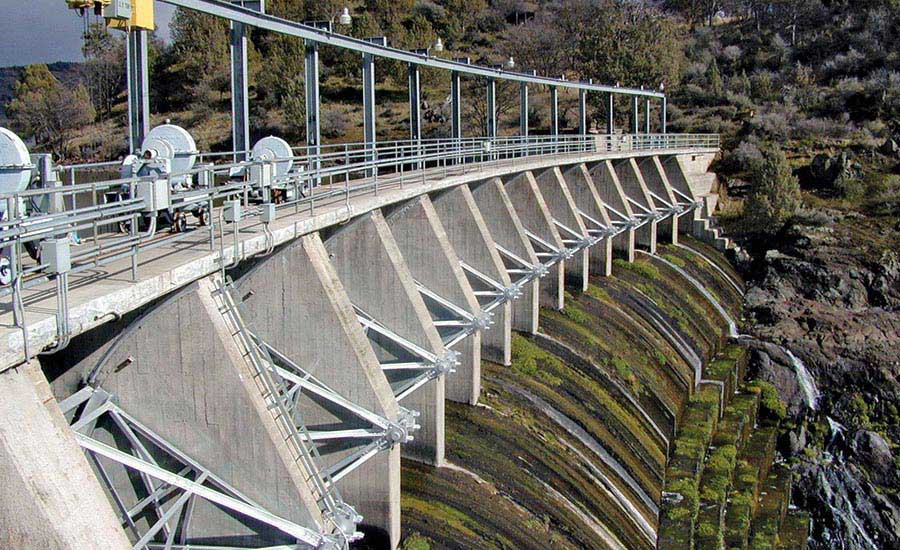What may be the nation’s largest dam removal project—delayed for years by regulatory and legal disputes of a utility, stakeholders and states over licensing and environmental permits—now may have new momentum after a hard-hitting January federal appeals court ruling.
Kiewit Infrastructure West, Granite Construction and Barnard Construction are shortlisted for the $400-million project to design and deconstruct four hydroelectric dams on the Klamath River in California and Oregon.
The Klamath River Renewal Corp. (KRRC), set up to oversee the dams’ removal, says it will select a contractor in the spring for the project. Work could begin next year and be completed in 2021. The project includes $200 million in financing from PacifiCorp, the dams’ private utility owner-operator, and up to $250 million in California bonds.
The dams—J.C. Boyle in Oregon and Copco I, Copco II and Iron Gate in California—were built between 1918 and 1962 and have an aggregate hydroelectric capacity of 43 MW but are operating at less than one-third of that and would be costly to upgrade. Three dams on the upper Klamath River in Oregon will remain operating. The Klamath dams produce a total of 169 MW, says PacifiCorp.
Long-Running Saga
The removal project stems from a settlement among Oregon, California and PacifiCorp reached in 2016 after years of squabble over environmental conditions since the utility began in 2004 to relicense the dams before transferring them to KRRC. The license expired in 2006, with the dams operating under interim annual licenses since.
States have a statutory deadline to complete a "certification" under Section 401 of the federal Clean Water Act within one year of a license application to the Federal Energy Regulatory Commission (FERC), required because of discharges into the water.
PacifiCorp and the states had been agreeing to defer the deadline since 2006 by annually withdrawing and refiling the application. Doing so kept FERC from waiving the states’ authority to issue the environmental certification.
But the Hoopa Valley tribe, whose reservation is downstream from the dams, in 2014 went to court after FERC declined its requests for a judgement on the annual certification delay tactic. The tribe raised concerns about rising removal and river reclamation costs that the delays were causing, and the capped project funding under the 2016 agreement.
License Held 'Hostage'
In a Jan. 25 decision, the Washington, D.C. federal appellate court rejected the FERC approach and remanded the case to the agency for new approvals.
The court sided with the tribe saying the withdrawal and resubmission scheme could not be used to indefinitely delay the federal licensing process. The court said it is “commonplace” for states to use Section 401 “to hold federal licenses hostage.”
Its opinion said that of 43 license applications pending at FERC, 27 are awaiting water quality certification by states and “four of those for more than a decade.”
The court ruled that a state waives its statutory authority by deferring review. “Section 401 was intended by Congress to curb state’s unreasonable delay,” the court said.
"Had FERC properly interpreted Section 401 and found waiver ... more than a decade ago, decommissioning of the project might very well be underway,” noted the ruling.
But the decision now will not affect the four dams because Oregon submitted its final environmental certification last September while California in late December issued a draft impact report that said removing the dams and restoring the surrounding area would result in “significantly more benefits” than continuing to operate them.
Public comment on the California report ends in late February.
FERC told KRRC on Jan. 23 that it expects by April 29 a revised final project cost estimate, with a "Plan B" for added funding if costs exceed the state cost cap, and a draft project agreement. The dam removal firm also will submit its Guaranteed Maximum Price (GMP) six to eight months after the project agreement is signed.
Under the original restoration plan, 400 miles of upstream habitat for salmon and steelhead trout will be restored, says a KRRC spokesman.
In its draft environmental certification, California said the dam removals would eliminate toxins, reduce dissolved oxygen concentrations and end pH fluctuations in the river.
Short-term adverse impacts included sediment discharge from reservoir drawdowns, but long-term effects would improve water quality and alleviate disease risks to fish, the state said.
Other Project Permit Impacts?
But some observers also see possible impact of the appellate ruling on other projects needing state environmental permits.
Kelly Catlett, director of the Western States Hydropower Reform Coalition, told ENR the ruling's effect on other projects is “gray” because of the case's narrow issues, and “will depend on FERC and how aggressive [it] is elsewhere.”
Others disagree.
Attorneys Sharon White and Michael Swiger of Washington, D.C.-based Van Ness Feldman, in a Jan. 28 analysis, say California and other states have put in place a comprehensive environmental review process as part of Section 401 decisions that take longer than one year.
With the ruling, FERC now appears "to have a mandate to reassert control over and shorten the length of the licensing process,” they said.
The ruling could affect FERC gas pipeline certifications, U.S. Army Corps of Engineers dredge-and-fill permits and other federal permitting that involves discharges into navigable waters requiring clean water-law certifications.
The implications of the court’s opinion “go far beyond FERC hydroelectric licensing,” White and Swiger said.






